April 3, 2009
Air Date: April 3, 2009
FULL SHOW
SEGMENTS
Hopeful Beginnings in Bonn
/ Steve CurwoodView the page for this story
The Obama administration has committed to work with the global community to take action on climate change. But the European Union fears the U.S. won’t make deep enough reductions in greenhouse gas emissions. Many developing countries want cash and access to meet tougher emission goals. Host Steve Curwood speaks with U.S. climate envoy Todd Stern and chair of the ad hoc working group of the UNFCCC Michael Zammit-Cutajar. (06:00)
Warming Debate Heats the House
/ Jeff YoungView the page for this story
As the world watches for signs that the U.S. will address climate change, an important signal arose from the U.S. House of Representatives: the first major global warming bill of the new Congress. Living on Earth’s Jeff Young tells us what’s in it and what big challenges lie ahead. (06:00)
Growing Rice Debt Free
/ Beth HoffmanView the page for this story
In recent years there have been many reports about desperately indebted farmers in India. Now, some farmer advocates there are trying to find low-cost and low-tech solutions to India's tired soil - solutions that can increase fertility and yield without more trips to the moneylender. Beth Hoffman reports. (07:30)
Not-So-Awesome Possums
/ Alan CoukellView the page for this story
In celebration of Earth Month, Living on Earth dips into our archives and revisits some of our favorite stories. In 2001, Alan Coukell reported on the problem of possums in New Zealand. The non-native species ate tens of thousands of tons of forest each day and can spread tuberculosis to other animals. Host Steve Curwood talks with Philip Cowan from New Zealand’s Land Care Research to find out how the battle to control possums has progressed in the eight years since our story was produced. (10:40)
Listener Letters
View the page for this story
Living on Earth hears what some of our listeners have to say. (01:55)
In Search of Silence
View the page for this story
Gordon Hempton has traveled the world in search of undisturbed natural sound. But as the audio ecologist describes in his new book, “One Square Inch of Silence; One Man’s Search for Natural Silence in a Noisy World,” it’s getting harder and harder to find pure natural sound. Hempton has launched a campaign to raise awareness about noise pollution, and tells Steve Curwood why silence matters. ()
This week's EarthEar selection
listen /
download
Coyotes, desert birds, and dry winds fill the soundscape at a New Mexican ranch.
Show Credits and Funders
Show Transcript
Host: Steve Curwood
Guests: Gordon Hempton, Michael Zammit-Cutajar
Reporters: Allan Coukell, Beth Hoffman, Jeff Young
[THEME]
CURWOOD: From Public Radio International - this is Living on Earth.
[THEME]
CURWOOD: I’m Steve Curwood.
The Obama crew goes to Bonn to re-engage with the UN treaty to fight climate change.
STERN: My team and I came here determined to make up for lost time. America is now once again strongly committed to developing a global response to climate change. We do not doubt the science, we do not doubt the urgency and we do not doubt the enormity of the challenge before us.
CURWOOD: And the Democratic leadership mounts a full-court press in Congress to get the job done.
MARKEY: We have an opportunity to back out millions of barrels of oil a day that we import, we have a chance to create three million new green jobs and to do so while we’re conquering global warming.
CURWOOD: But it’s far from a done deal – and reluctance to take strong action in Congress is a bi-partisan affair. That - and more - this week on Living on Earth! Stick around.
[NEWSBREAK MUSIC: Boards Of Canada “Zoetrope” from “In A Beautiful Place Out In The Country” (Warp Records 2000)]
ANNOUNCER: Support for Living on Earth comes from the National Science Foundation and Stonyfield Farm.
[THEME]
Hopeful Beginnings in Bonn
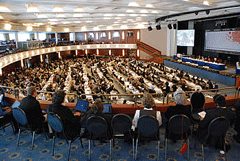
UNFCCC delegates in session. (Photo: Leila Mead)
CURWOOD: From the Jennifer and Ted Stanley Studios in Somerville, Massachusetts - this is Living on Earth. I’m Steve Curwood.

Downtown Bonn, Germany.
STERN: My team and I came here determined to make up for lost time. America is now once again strongly committed to developing a global response to climate change. We do not doubt the science, we do not doubt the urgency and we do not do not doubt the enormity of the challenge before us.
CURWOOD: Mr. Stern said the US now plans to reduce its global warming gas emissions back to 1990 levels by 2020 and make an 80 percent cut by 2050. Mr. Stern also explained why the US would continue the talks among the world’s sixteen major greenhouse gas emitters.
Many negotiators saw this Bush Administration initiative as a snub to Kyoto – but Mr. Stern said it will now be useful because top UN climate officials will also be at the table.
STERN: This isn't a negotiating forum but we hope it will be an opportunity to have the kind of discussion that can facilitate agreement in Copenhagen.
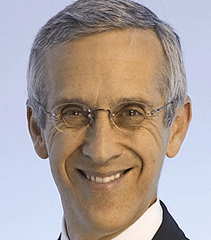
Todd Stern. (Courtesy of the U.S. State Department)
Despite these moves, the US is still coming under fire for doing too little too late. Michael Zammit-Cutajar chairs the working group that’s charged with coming up with language for a renewed climate treaty by the final meeting scheduled for December in Copenhagen. I asked him what underlies the present criticism of the US.
ZAMMIT-CUTAJAR: Well, I think we’re all very encouraged by the re-engagement of the USA and President Obama. The U.S. administration is caught in the position which it inherited on the 20th of January and its judgment of the best it can do with that starting point is that it can get back to 1990 levels by 2020. Now, this is twenty years later than what was required by the convention signed in 1992, ratified in 1994. The E.U. by comparison has been working on its emissions limitation goal all the while. It hasn’t missed out on the eight years that preceded President Obama, and its picture is somewhat different. It is aiming to be twenty percent or even thirty percent below 1990 levels by 2020. So those are the two figures on the table, and that is why some people are saying what the U.S. is doing is not enough. Now if you measure both efforts - E.U. and U.S. - from a different baseline from where they both where in 2005, you’ll find that the reduction effort is comparable.
One of the debates that is still ahead of us and that we’re going to have in the next days here is this question of comparability and how do you compare effort in different national circumstances. Countries can do more or less depending if they’re big or small or cold or warm, etc. What the E.U. has said is that it’s committed unconditionally to a twenty percent reduction below 1990 levels. If other developed countries make comparable efforts, and it hasn’t defined what that means, it will go to thirty. So that’s the E.U.’s negotiating position. I guess that the E.U. is trying to encourage the U.S. to go a step further than what it’s already said.
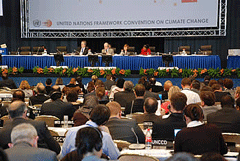
Delegates meet in Bonn, Germany. (Photo: Leila Mead)
ZAMMIT-CUTAJAR: I can’t answer that question, you know. The U.S., first of all, has a lot to do to convince itself, I mean its Constitutional bodies, its public opinion, its industrial and labor interests, what it can do and what it should do. From what I can understand the U.S. is looking very closely at what China will do. China in a very different category in terms of level of development, yet the other big country around. But reducing or limiting emissions growth is not the only question on the table. That is what we’ve talked about so far. The other number that is important goes with a dollar sign. How much money the rich industrial countries are willing to put on the table and on what conditions to enable actions by developing countries to make their fair contribution.
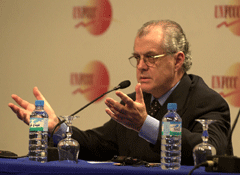
Michael Zammit-Cutajar (Photo: Leila Mead)
ZAMMIT-CUTAJAR: It’s a very diverse group. But the group as a whole is looking for strong leadership from developed countries, such as the U.S. Strong leadership on cutting emissions, so there’s a certain sense of wait and see. You are committed to lead, that is in the convention. Once we see what you are doing to express your leadership, then we will follow. That is what China is saying. And that’s what the littler ones are saying. And then there’s the question of finance. We need help from you, sometimes it’s money, sometimes it’s more access to technology, to do what we need to do, what you would like us to do to contribute to the global effort.
CURWOOD: Michael Zammit-Cutajar, Chairman of the Climate Change Convention’s working group.
Related links:
- Follow the Bonn and related proceedings at the United Nations Framework Convention on Climate Change website, as delegates gear up for the 15th major Conference of the Parties in Copenhagen, Denmark in December, 2009.
- Full texts of press briefing and plenary speech on March 29, 2009 by U.S. Special Envoy for Climate Change, Todd Stern
- Listen to Living on Earth’s coverage of talks in Poznan, Poland.
Warming Debate Heats the House
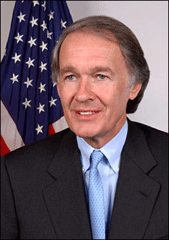
Congressman Edward Markey. (Courtesy of the House of Representatives)
CURWOOD: Back here at home, Congress has been gearing up for action on climate change too – with a draft bill coming out of the powerful House Energy Committee that is fairly close to what the White House has put on the table in Bonn.
Living on Earth’s Jeff Young joins me now from Washington. Hi Jeff.
YOUNG: Hi Steve!
CURWOOD: So this bill comes out the very same week the US shows its hand at the talks leading up to Copenhagen.
YOUNG: And probably not merely coincidence, that - I caught up with Ed Markey, he’s the Massachusetts Democrat who’s one of the lead authors of this bill. Markey says he wants to make sure that congress does enough so that when the Obama administration goes to Copenhagen for those talks in December the US is seen as a leader, not the laggard, in his words.
And this draft bill Markey helped write is very ambitious. It would mandate greater energy efficiency, much more use of renewable energy sources, and deep cuts in carbon dioxide emissions.
MARKEY: We have opportunity to back out millions of barrels of oil we import. We have a chance to create three million new green jobs and to do so while we’re conquering global warming. So it’s too good an opportunity to miss.
YOUNG: Markey says he and Energy Committee Chairman Henry Waxman of California followed the guidance of a coalition of major business and environmental groups in setting the CO2 emissions targets. The bill would establish a cap-and-trade program to cut CO2 83 percent below 2005 levels by mid century. It also calls for a 20 percent reduction by the year 2020. That’s a slightly stronger cap than the Obama administration requested, but somewhat weaker than what some climate scientists recommend. Markey says he will also keep energy intensive industries in mind when deciding how to allocate the emissions credits
MARKEY: We are not going to auction off 100 percent of the credits. We are going to use some of them in order to insure that the steel industry, and the glass industry, the paper industry, and other trade vulnerable, energy intensive industries are not exploited by China or India or Brazil or other countries that have not yet agreed to be part of a global system of controlling greenhouse gases.

Congressman Edward Markey. (Courtesy of the House of Representatives)
CAPITO: The direction of which this legislation seems to be taking it is to kill coal, quite frankly.
YOUNG: That’s West Virginia Republican Representative Shelley Moore Capito. House Republican leaders have tagged the bill a “light switch tax” and any Republican support seems unlikely.
The bill is also divisive among Democrats. Democrat Rick Boucher represents the coal mining part of Virginia. He’s also a key member of the House Energy Committee and managed to add to the bill significant support for carbon capture and storage technology. That’s the coal industry’s best chance to comply with carbon cuts in the long term. But that technology is unlikely to come about for at least a decade. Boucher’s very concerned about the near term targets for emissions reductions, from 2012 to 2020.
BOUCHER: And that is a critical time, because it’s the time during which we will be developing the technologies that will allow our most plentiful fuel, coal, accounting today for 51 percent of all electricity production in this country, to be continued in use.
YOUNG: The trick, of course, is to also have those targets accomplish what’s needed to avoid dangerous levels of warming.
The Obama Administration is sending clear signals that there is ample science to justify action now. As head of the National Oceanic Atmospheric Administration, or NOAA, Jane Lubchenco is one of the administration’s top science advisors. Lubchenco told the national academy of sciences that the climate change situation reminds her of warnings penned 40 years ago by Martin Luther King Jr.
LUBCHENCO: We cry out desperately for time to pause in her passage but time is deaf to every plea and rushes on. Over the bleached bones and jumbled residues of numerous civilizations are written the pathetic words ‘too late’.
YOUNG: Clearly, Lubchenco is in no mood to wait. And neither are her colleagues at the Environmental Protection Agency, who are pressing ahead with the first steps to regulate CO2 using existing authority under the clean air act.
California Democratic Senator Barbara Boxer, who chairs the Senate Environment Committee, says that should send a clear signal to her colleagues in Congress.
BOXER: Action is underway to stop global warming now. The EPA is already moving to regulate greenhouses gasses under the Clean Air Act. If congress does nothing we’ll be watching EPA do our job, because they must do it under the Clean Air Act.
YOUNG: So Steve – Boxer and her allies hope that EPA’s promise to regulate will help them legislate instead.
CURWOOD: And it’s helping the Obama administration negotiate, because more than one delegate in Bonn mentioned to me that they’re well aware that the president will have the power to regulate greenhouse gases through the EPA. Just where are they in that process?
YOUNG: The new EPA administrator Lisa Jackson, she’s made this finding that carbon dioxide emissions are a potential danger to public health and welfare. That is the legal trigger that really starts the ball rolling. It’s not clear what form the regulation will take but it is underway.
CURWOOD: Jeff, help me out – the legislation, all these numbers – what does it mean for the typical American?
YOUNG: You know, it is so confusing, these targets. I spoke with Princeton Professor Robert Socolow, who has a very personal way of looking at this. He says if we want to stabilize CO2, we’ve gotta get to one ton of CO2 per person per year. Right now the U.S. averages 20 tons per person per year.
CURWOOD: That’s a pretty tall order, Jeff. Living on Earth’s Jeff Young in Washington. Thanks.
YOUNG: You’re welcome.
[MUSIC: Carlos Santana “Curacion (Sunlight On Water)” from Multi-dimensional Warrior (Legacy 2008)]
CURWOOD: Just ahead – digging out of debt – the organic way. Keep listening to Living on Earth!
Related links:
- Read the discussion draft of the climate change and energy bill from Representatives Waxman and Markey.
- Read press release about the draft from the House Energy and Commerce Committee.
- Listen to Jeff Young's earlier report on the complex Senate politics for a climate bill.
- And hear our interview with EPA Administrator Lisa Jackson.
- Learn more about the National Academy of Sciences climate change study
[CUTAWAY MUSIC: Jake Shimabukuro: “Thriller” from Live (Hitchhike Records 2009)]
Growing Rice Debt Free
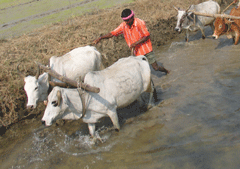
Rice farmers plow oxen in Orissa, India. (Photo: Subhashree Pradhan)
CURWOOD: Throughout the world, farmers have become increasingly dependent on artificial fertilizers and pesticides to boost production. But the costs are high – and many poor farmers end up buried in debt.
Beth Hoffman reports now from Orissa, India on attempts by farmers there to break this cycle of chemical dependency.
HOFFMAN: It was a hot and dry day in January when I met the Krishna family in the cool of a grass shade structure beside the family’s rice field. In front of us, on the hard packed mud “patio,” sat a small mound of rice, what is left of the harvest for this year. Much of the rest has gone to pay the local moneylender, who just so happened to pay a visit while I was there.
[KRISHNA TALKING]
KRISHNA: That was the moneylender. I borrowed 2000 Rupees from him in June, and now, six months later, he’s come to collect 5000 Rupees worth of rice.
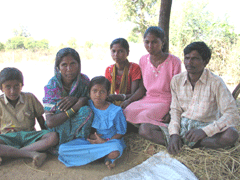
The Krishna family—rice farmers in Nuapada District of Orissa, India. (Courtesy of Beth Hoffman)
KRISHNA: We don’t have goats, we don’t have cows. And because there are less cattle now all the families are using chemical fertilizers.
HOFFMAN: Without cows and cow dung, farmers have to buy chemical fertilizers like urea and phosphate. But over the past five years, while the cost of that fertilizer has risen, yields have dropped. Many, including Nimain Charan Swain, the Deputy Directory of Agriculture in Orissa, believe the low yields are in fact caused by chemical use.
SWAIN: The thing is that from applying the fertilizer for so many years, the soil health is reduced.
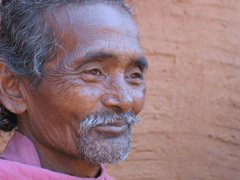
Rice farmer Buddharam Dal says he’s struggling to pay back
loans he took from the local moneylender. (Photo: Beth Hoffman)
SWAIN: To revive the soil health, the government is now trying biofertilizers, biopesticide. These are things that encourage the farmers not to use chemical fertilizer.
HOFFMAN: But while officials say they support eco-friendly agriculture, that’s not how the government has been spending its money. This year the Indian government will spend one billion dollars on subsidies paid directly to fertilizer companies.
[KRISHNA SPEAKING]
HOFFMAN: So Krishna, and thousands of farmers like him, are stuck – taking out loans to pay for something that harms their soil. Yet somehow he remains optimistic that things will change for his family, someday.
KRISHNA: This year I don’t think we will have enough to eat. I think it will take about five years for us to pay off the debt we have. Then things will be better in the future.
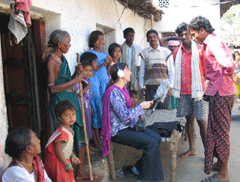
Reporter Beth Hoffman records a farmer singing a traditional song sung to oxen while rice farming. (Photo: Subhashree Pradhan)
[PRO-BIOTECH PROPONENTS: “Over the past hundred years our food supply has greatly”…”Imagine, a world with enough food for everyone and a clean, healthy environment”….”As a scientist working with biotechnology, I know the scientific side…”]
HOFFMAN: But all these answers are expensive and often rely on unreliable governments. Instead, advocates in rural India believe the solution is to make farmers more self-reliant, by using free, low-tech solutions, like organic farming and something called SRI, a System of Rice Intensification.
[SOUND OF PEOPLE WORKING IN THE MUD]
HOFFMAN: A group of men and women work in knee high mud with rope and a tool that looks like an oversized pizza cutter. They draw a grid in the mud and plant the seedlings in this grid.
[SOUND OF PEOPLE WORKING IN THE MUD]
NIAL: I am telling him this is the long process – it takes time, a long time.
[SOUND OF PEOPLE WORKING IN THE MUD]
HOFFMAN: Suklambar Nial works with a local non-profit, training farmers in SRI. The method uses as little as one tenth of the seed and far less water than conventional rice farming. And the yields have been impressive.
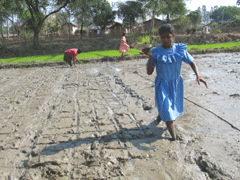
A school girl helps plant rice seedlings in the SRI grid pattern. (Photo: Beth Hoffman)
[SOUND OF PEOPLE WORKING IN THE MUD AND TALKING]
HOFFMAN: These results have not gone unnoticed. Worldwide, there are now an estimated one million farmers using the SRI method. The World Wildlife Federation, and the World Bank, now sanction its use. And there are no patents or intellectual property involved – it’s free for farmers to use.
[SOUNDS OF PLAY]
HOFFMAN: These farmers are excited enough about the technique that they invited me back that evening – to watch a play they developed, where farmers teach one another about SRI.
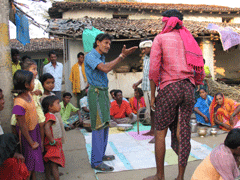
Farmers present a play about SRI farming in the town of Krishna in Nuapada, Orissa. (Photo: Beth Hoffman)
HOFFMAN: But even with good farming techniques, poor farmers still need a source of nitrogen to keep the soil fertile.
[SOUND OF STIRRING]
HOFFMAN: A few miles away lives Belmati Sabar, also a rice farmer. She and her family are from a lower caste, with little in the way of property or cows. So to take care of her fields, Sabar stirs a mixture of what she calls “magic compost” – a fermented concoction of leaves from common plants, homemade sugar and a small amount of cow dung she collects on the streets of her village.
NIAL & SABAR: After 10 to 12 days it will make compost.
HOFFMAN: The mixture is not a new idea - it has been used for centuries in India. But scientists have worked to update and improve the recipe. Plus, like SRI, it’s free and uses only items easily found, keeping money in the village.
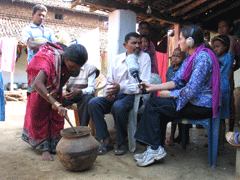
Belmati Sabar stirs her magic compost while reporter Beth Hoffman records. (Photo: Subhashree Pradhan)
HOFFMAN: Here a farmer sings a traditional song sung to oxen while plowing the rice fields, now adapted for the farmers' SRI play. He too is using the old to connect with the new, updating the traditional with the scientific. Continuing the way farming has always evolved.
For Living On Earth, I am Beth Hoffman in Orissa, India.
[SINGING]
CURWOOD: Just ahead – searching for the quiet places of nature in our noisy world. Stay with us - on Living on Earth.
ANNOUNCER: Support for the Environmental Health Desk at Living on Earth comes from the Cedar Tree Foundation. Support also comes from the Richard and Rhoda Goldman fund for coverage of population and the environment. And from Gilman Ordway for coverage of conservation and environmental change. This is Living on Earth on PRI, Public Radio International.
Related links:
- For more on Norman Uphoff, click here.
- To learn about the System of Rice Intensification (SRI) in Bangladesh, click here.
- For more on Sahabhagi Vikash Abhiyan, click here.
- For more on reporter Beth Hoffman, click here.
[CUTAWAY MUSIC: Beatlejazz: “Blue Jay Way” from Another Bite Of The Apple (Zebra Records 2001)]
Not-So-Awesome Possums
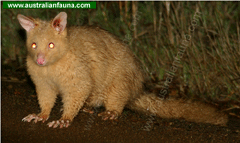
The Brushtail Possum.
CURWOOD: It’s Living on Earth, I’m Steve Curwood.
In the run-up to Earth Day, we’re revisiting some favorite stories from past years – and checking out what’s happened since.
Today – a report from 2001, from New Zealand. For most of its history, the New Zealand islands were isolated and remote with unique ecosystems. When human settlers arrived, some 800 years ago, they brought in new animals and plants, and often, native species had few defenses against them.
Among those new arrivals was the Australian possum, which thrived and spread nationwide, and became a threat to forests and livestock. As Allan Coukell reported, trapping and poisoning possums isn’t very effective so scientists have been seeking alternative control methods.
[SOUND OF FOOTSTEPS]
WAAYER: Around this time of night they'd be starting to come out of their burrows and hiding places. And they live off the nicest of foliage, which is why we're always after them.
COUKELL: It is dusk on this New Zealand farm near the town of Warkworth, about an hour north of the city of Auckland. Armed with a spotlight and 22-caliber rifle, Tom Waayer is preparing to defend his land against an alien invasion.
WAAYER: Here's our first one, see him in the tree there? See, here we go with this.
[SHOOTS RIFLE]
COUKELL: I think he fell.
WAAYER: He's fallen partway.
[SHOOTS AGAIN]
COUKELL: The enemy he's targeting is the Australian brush-tailed possum. Over the next three hours Tom Waayer will shoot nine more possums on his small farm. These few animals no longer pose a problem, but there are still at least 70 million more possums in New Zealand. And tonight across the country, like every night, they will eat about 20,000 tons of vegetation.
COWAN: We've been looking at the interaction between possums and vegetation since the mid-1960s.
COUKELL: Phil Cowan is an ecologist at the government-owned company Land Care Research. He says that the possums have been in New Zealand for more than a century. Their environmental impact has far from stabilized.
COWAN: What we’ve found over the last 30 years is that although possum numbers have basically remained constant, what we see is continuing degradation of the forest. Possums continuing to kill preferred tree species and changing the whole composition of the forest. And that, presumably, affects the whole way that the forest ecosystem operates.
[BIRD CALLS]
COUKELL: Possums also snack on rare snails and insects, and prey on the eggs and young of critically endangered birds, such as kiwi and kokako. But just as important as the effect of possums on native forests is the risk to agriculture. At any given time, over 600 herds of cattle and farmed deer in New Zealand are infected with bovine tuberculosis, a disease passed on by the possums. In the course of a year about one-and-a-half percent of herds is infected, eight times the accepted international standard. New Zealand spends roughly $25 million a year on TB control in livestock. Cattle and deer are inspected, herds are quarantined, and infected animals killed. But fully half the money spent goes to trapping and poisoning possums. Morgan Williams is New Zealand's Parliamentary Commissioner for the Environment. He says getting rid of possums with these methods is nearly impossible.
WILLIAMS: Possums in many parts of New Zealand are in very rugged country, so it's not a matter of wandering around easily and putting out a little bit of bait or bit of trapping. And you've got to keep going back every few years because you never get the last possum. And with the amount of food that's in our forests, possum populations recover again quite rapidly.
COUKELL: Ecologist Phil Cowan agrees that the current methods of control are inadequate. He says what's needed is a cheaper and more effective way to eradicate the animals.
COWAN: We need to look for new technologies so we can do things much more cost-effectively and do possum control, not just in the highest priority areas, but over the whole of New Zealand, if at all possible. So what we're working towards is developing some kind of biological control that, together with conventional control, we can use to achieve that goal. What we're trying to develop in effect is a form of contraception for possums.
[POSSUM CALLS]
ECKERY: This is our possum breeding facility. We've made quite an effort in the first years of our research into possums and gaining a basic understanding of possum biology.
COUKELL: Doug Eckery is a reproductive physiologist at AgResearch, another government organization. He spends his time figuring out how to manipulate the reproductive activities of the marsupials. It's part of the overall goal of a vaccine that will cause the possums to lead happy, but childless, lives.
[POSSUM CALLS, A DOORS SHUTS]
ECKERY: So, these are sort of the spoiled possums here. We do monitor the reproductive activity from them. That entails just taking a urine sample from them every day, but they're on a reward system, so when they give their urine sample they get a little piece of bread with jam on it. So most of them are more interested in getting their jam sandwich than worrying about what we're up to.
[POSSUM CALLS]
COUKELL: The aim of the research is to sterilize as many possums as possible. So scientists are enlisting the animal's own immune system using proteins from possum sperm and egg to create a vaccine that will prevent fertilization. Initially, the plan is to introduce the vaccine in the form of genetically modified carrots. But such a bait-delivered vaccine will still only reach a small percentage of the entire possum population. So Joanne Meers, a virologist at Massey University, is working to find a virus that could be used to spread sterility from one possum to another.
MEERS: Viruses have an advantage over other delivery systems, in that it gives two chances or two hits at being specific for possums. Not only have we got a virus that will only infect possums, but we also have a bit of - the protein is also specific for possums. So we have two prongs in the attack of being specific for possums.
COUKELL: Developing an infectious agent that spreads sterility requires a great deal of caution. The scientists will have to proceed carefully to ensure that the virus affects only possums and not humans or other animals.
Scientists predict that a one-third reduction in possum numbers will safeguard New Zealand agriculture. But they also know they will have to do much, much better than that if the forests are to recover and birds such as the kokako are to sing again. For Living on Earth I'm Alan Coukell in Auckland, New Zealand.
[BIRD SONG]
CURWOOD: And listening with me now to Allan Coukell’s report is ecologist Phil Cowan from New Zealand’s Land Care Research. And Phil, you’re still on the possum control beat – what kind of success have you been having?
COWAN: I suppose it’s mixed in some places and really good in others. In terms of the TB situation, the success has been really good. When we last discussed this I think New Zealand has about 600 infected herds while the latest figures are less than 140, so that’s really positive. In terms of impacts on native biodiversity and native forests, progress has been more mixed. But that’s partly because possums are just part of the problem. A number of endangered species are also threatened by some of the introduced predators, particularly rats and stoats and weasels. And so control has now switched from a single focus on possums to a focus on a suite of species that are all impacting on forests and on native birds.
CURWOOD: By the way, how is the kokako doing?
COWAN: Kokako is doing great. Kokako populations have been increasing steadily over the last five years, and that’s largely because of the continued pressure of pest control in keeping rats and possums down.

The Australian Brushtail Possum.
COWAN: We’ve continued with the research on fertility control, and we’ve been able to show that we can get infertility if we inject the possum egg proteins, for example. The issue has been how can we deliver those to the supposed seventeen million possums. And so we’ve been looking at trying to develop a method of delivering these orally in a bait. So that’s a real challenge. In terms of the virus work which was aimed at producing a method of biological control that would transmit naturally from possum to possum – the virus work got put on the back burner, but we have continued similar work, but this time looking at using a possum specific parasite, a worm that lives in the possum’s intestines, as a means of transmitting fertility control from possum to possum. While we’ve made significant progress in the lab, we’re still a long, long way from any idea of being able to release that into the field. And there would be a very long process involving a lot of public consultation before something like that could ever be released for practical use.
CURWOOD: By the way, how did possums wind up in New Zealand anyway?
COWAN: They were brought to New Zealand in the 1850s to set up a trade in the fur. At that time Australia used to export a very large number of pelts from possums to the Hudson Bay Company for auction on the world fur market. And so this was seen as another way in which the early colonists of New Zealand could increase their income.
CURWOOD: So what about bringing back the possum coat? Maybe that would get you some help from traders and entrepreneurs.
COWAN: Yeah, we – New Zealand stills harvests probably a million possum skins a year which get made into a variety of articles, but the big change in that industry has been that rather than using the skins so much these days, what people do is they pluck the fur from the possums once they’re dead and they blend that fur with merino wool and make very high quality garments like sweaters. Possum’s hair fibers are very light and silky and they have very good insulting properties and they make really high quality garments.
CURWOOD: Ah, so move over the cashmere goat, huh?
COWAN: That’s right.
CURWOOD: Phil Cowan is head of the Science and Pest Control Technologies team and New Zealand’s Land Care Research. Thanks so much.
COWAN: Okay. Thanks, Steve.
Related links:
- Introduced Birds and Mammals in New Zealand and Their Effect on the Environment, 1984
- For more on the Australian possum, click here.
[MUSIC: Fareed Haque “The Chant” from Flat Planet (Owl Studios 2009)]
Listener Letters
CURWOOD: It’s Living on Earth, I’m Steve Curwood.
[LISTENER LETTERS THEME]
CURWOOD: Time, now, to dip into the email bag.
Sue Rosenthal, who listens to our show on KQED in the San Francisco Bay Area, was dismayed to hear our story about sequestering CO2 in ultramafic rocks. She writes that the most common ultramafic rock where she lives is serpentinite, and using it for carbon storage would pose a huge threat to native ecosystems, because “many serpentine endemic plants are rare and endangered.”
Several listeners queried author Jack McEnany’s claim that the slang term “hooker” for a prostitute was related to logging. Ken Kowalchek, who hears us on the Maine Public Broadcasting Network, writes, “Legend has it that the popularization of the term came from the band of young ladies who followed the Army of the Potomac commanded by Massachusetts Civil War General Joseph Hooker.”
But Keith Washington, who listens to WBUR in Boston, writes that the term was derived from an area in or near New York City – “Corlear’s Hook” – noted for its many houses of ill fame.
Both these explanations are widespread, but further research suggests the term actually predates the civil war, and probably comes from the verb to hook, or swindle.
Many listeners responded to our story about oil drilling in Central Park. WHYY listener Richard Horwitz from Springfield, Pennsylvania thought it “a revolting idea” and said we should have mentioned that the Central Park Police Station has been generating all its electricity from fuel cells since the year 2000.
But other listeners were on the same page as Pat Fletcher, a New York resident for 14 years, who now lives in Tacoma Washington, and hears us on KUOW.
FLETCHER: That was pretty funny! You had me going at first - On one level, I wouldn't put it past New Yorkers, especially with their current mayor, to do something like this. And then I remembered – APRIL FOOLS!!
CURWOOD: You can hear our program any time on our website or get a download for your MP3 player. The address is loe.org, that’s loe.org. There you’ll also find pictures and more information about our stories. And we’d like to hear from you. You can reach us at comments@loe.org. Once again, that’s comments at loe.org. Our postal address is 20 Holland St. Somerville, MA 02144. And you can call our listener line anytime at 800-218-9988. That’s 800-218-9988.
In Search of Silence
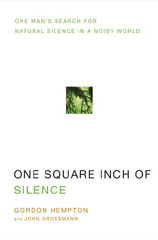
Gordon Hempton has dedicated his life to listening. As an acoustic ecologist, Mr. Hempton has captured audio landscapes on every continent except Antarctica, criss-crossing some of the most unbeaten paths on the globe with his recording equipment.
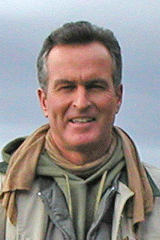
Author Gordon Hempton.
Gordon, please describe this place, this one square inch of silence for me?
HEMPTON: Yeah, so Olympic National Park is truly the listener’s Yosemite. It’s often called three parks in one because there are three areas that in another park would justify its entire existence. We have glacier-capped mountains, we have the temperate rain forest and we have a wilderness seashore. Now this is a world heritage site and also a biosphere reserve. It’s a wonderful place simply to be and to listen to the widest diversity of sounds of any national park in the 390 units that the National Park Service manages. But even more important to my ears is the fact that Olympic National Park has the longest duration of natural quiet than in any other national park.
CURWOOD: Tell me exactly where is this one square inch of silence.
HEMPTON: One square inch of silence is three point two miles up the Hoh River Trail, a trail that’s lined with the world’s tallest living creatures, moss covered, dug fir, western hemlock, western red cedar, sitka spruce. On a moss-covered log, I placed a stone given to me by the Quileute elder, David Fourlines.
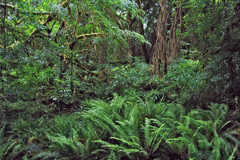
The Hoh Rainforest, home of one square inch of silence. (Courtesy of Gordon Hempton)
CURWOOD: We have some of your sound from this place. Let’s play it right now.
[BIRDS SOUNDS, BUZZING, CROAKING]
CURWOOD: Well, actually, this is a pretty busy place, Gordon.
HEMPTON: Oh it can be. That’s definitely a springtime recording. It’s busy, lot of wildlife. We’re hearing a varied thrush there, a pacific chorus frog. They’re as busy communicating as we are. They have more important things to say, I think, than we have to say when we’re in a wilderness area. Our job is basically to listen. The frogs, the varied thrush, the winter wren, all these creatures are busy establishing their territories, hoping to find an additional mate. And you know, that brings up another question too, because not only does noise from outside sources impact our park experience, but it also impacts wildlife.
CURWOOD: Why do ecosystems need to be free of human noise?
HEMPTON: Steve, I think the whole earth is speaking. I hear it speaking. And so to ask me which ecosystem deserves to be heard, I think they all deserve to be heard. They all have something to say. Imagine this: all higher vertebrate species have the ability to hear, although not all species have the ability to see – hearing is vital for survival. And we don’t have ear lids, do we? In fact, no creature has ear lids, although we seem to have plenty of eyelids. It’s not only important that we hear, but it’s important that we listen. And I don’t think that we’re an exception to the animal kingdom.
So, if I would say what are my big, you know, hit list or first go, first see, first listen to the ecosystems, well, I would just jump right into the Amazon, because the earth is a solar powered jukebox. The more sun that hits the surface of the earth, basically, the louder it is. The Amazon, you know, that natural silence per se is really ripping, it’s a conversational voice. It is so ever-changing that you can identify the correct time of day just off the sound alone within five minutes.
And then jump up to Central America. I like Belize particularly.
And jump up further, it’s the songbirds of the southeast in Georgia. Of course, we’re in a economically developed country now, the United States, and with all that fossil fuel consumption, the solar powered jukebox is getting a little refigured because of all the transportation of this solar power.
And then jump up to the Canadian border here in eastern Washington, also western Washington, and there’s a poetics of space that’s just really remarkable, because, when you make a quiet recording, like the recording of coyotes singing, is this a recording of coyotes, or is this a recording of silence made audible by coyotes?
[COYOTES HOWLING]
HEMPTON: Listen closely, Steve, because there’s not one coyote, but there’re two. And they’re singing to each other after a long season of prosperity and to me it sounds like a celebration. But the point that I think that they really bring out is that if there were the slightest jet rumbling in the background, the experience of these coyotes would be entirely different.
[COYOTES HOWLING]
HEMPTON: Another recording, which I think will just really floor you, just like it floored me. I heard this – I read in John Muir’s journals – he describes snow melting into music. So, when you hear somebody say that or you read it yourself, you go “Oh, well what a poetic license. Isn’t that great.” But little might we guess, unless we actually do listen.
[SOUNDS OF SNOW MELTING, MARMOT CALL]
HEMPTON: That’s the Olympic marmot by the way, that’s an endangered species. It’s an endemic, just there at Olympic National Park.
[MARMOT CALL, SOUND OF SNOW MELTING]
HEMPTON: At this point you don’t know how hard it was for me not to just like stand up, wreck that recording because I just had to dance. I mean, yes, John Muir, thank you.
CURWOOD: Well I didn’t know Ma Nature was a jazz musician.
HEMPTON: Oh yeah, sure is. Are you a player yourself?
CURWOOD: [laughing] Nothing you’d want to have on the air
[LAUGHING]
HEMPTON: Okay.
CURWOOD: And, of course, people know John Muir as the naturalist who was the founder of the Sierra Club and inspired much of what we have in the way of national parks. And I gather you actually went to the place in Montgomery, Tennessee where Muir had his own epiphany about the environment. So tell me, Gordon, why was this one creek in Tennessee so important for you to visit and what was it that you found there?

CURWOOD: So when you get there, who’s there? Who do you meet?
HEMPTON: Well I find the creek, and I meet Randy. Randy is operating this large water truck for the National Coal Plant. And he sucks up water – he says that there’s no water, no coal – he says. And so he’s sucking up like a thirsty elephant, and then he drives off. But not until he gives me a suggestion on where I might find quiet.
CURWOOD: If you could read from that, it would be wonderful.
HEMPTON: “At Randy’s suggestion, I’m walking Roach’s Creek up the valley imagining I’m in Muir’s footsteps. Walking in the stream itself, I’m able to hear its changing voice. No two rocks are the same, no two flows are the same. At every step, a new combination, new notes. In a different time, Muir’s time for instance, I could have lost myself in these subtle variations, but with the distant din of National Coal Corporation mine number eleven in the background, it’s impossible to bend a calm ear. ‘Nothing more eloquent in nature than a mountain stream,’ Muir wrote in his journal very near to where I’m standing. What would he write today?”
CURWOOD: Gordon, we live in noisy culture, what’s to be done?
HEMPTON: Well our culture is noisy. What we can do today, number one, is include quiet in your life, simply include quiet in your life. Silence cannot be imagined, although a lot of people think so. Most people that are listening to this are recalling a quiet place that they have been in the last year. Well, I have to say, listen again.
CURWOOD: Tell us about an encounter or moment that just gave you hope for the future of the sound of nature in America, quiet in America.
HEMPTON: Every opportunity to hear nature undisturbed by motor noise inspires me, gives me hope. There are two places where that did happen on a ten thousand mile trip. And one in particular was Canyonlands, Canyonlands National Park, and many people may know this either personally or from the writings of Edward Abbey. And it’s there at night where you can look at the countless stars and simply be and breathe with the sighing of the wind – such a deep and peaceful sleep – and to be able to gaze out at – instead of trees that are hundreds of years old – you’re gazing out at a moonlit landscape where the rocks are millions of years old. This is a witness to being a miracle. How can we not gain inspiration? So, when I think about how are we going to quiet our culture, well for one thing, I don’t think there’s any choice. And the immense benefits from this – health for ourselves and also for wildlife – I believe we will. I believe we’ll quiet it. Beginning with Olympic National Park.
CURWOOD: Gordon Hempton’s book is ‘One Square Inch of Silence.” Thank you so much, Gordon,
HEMPTON: Thank you, Steve.
Related link:
Check out the One Square Inch of Silence website
[MUSIC: Bombay Dub Orchestra “Greenish Blue” from 3 Cities (Six Degrees 2008)]
CURWOOD: On the next Living on Earth, spring wakes up remote Montana.
BASS: The grizzly mothers with their cubs slide down the slopes on their backs. They ride the ice to the bottom, cartwheeling into the fields of lilies resting at the bottom of the vanishing glacier - and then climb right back up to the top.
CURWOOD: The joy of the world reborn - next time right here on Living on Earth.
[DESERT SOUNDS]
CURWOOD: We leave you this week in “Desert Solitude.”
[DESERT SOUNDS]
CURWOOD: Not a plane flies overhead nor a car drives by this section of Gray Ranch, a 500 square mile Nature Conservancy easement in the panhandle of New Mexico. Bernie Krause found his patch of silence at dawn. He recorded coyotes, desert birds, and dry winds for his series wildsanctuary.com.
[DESERT SOUNDS: Bernie Krause “Desert Solitudes from Desert Solitudes (Wild Sanctuary 2002)]
CURWOOD: Living on Earth is produced by the World Media Foundation. Our crew includes Ashley Ahearn, Bobby Bascomb, Eileen Bolinsky, Bruce Gellerman, Ingrid Lobet, Helen Palmer, Mitra Taj and Jeff Young, with help from Sarah Calkins and Marilyn Govoni. Our interns are Lindsay Breslau, Phil DiMartino, Liz Gross and Christine Parrish. Jeff Turton is our technical director. Alison Lirish Dean composed our themes. You can find us anytime at loe.org.
I’m Steve Curwood. Thanks for listening.
ANNOUNCER: Funding for Living on Earth comes from the National Science Foundation, supporting coverage of emerging science, and Stonyfield Farm: organic yogurt and smoothies. Stonyfield pays its farmers not to use artificial growth hormones on their cows. Details at stonyfield.com.
Support also comes from you our listeners, the Ford Foundation, the Town Creek Foundation, and the Oak Foundation supporting coverage of climate change and marine issues; The Rockefeller Foundation and its Campaign for American Workers. More at rock found dot org. and Pax World Mutual Funds: socially and environmentally sustainable investing. Pax World: for tomorrow. On the web at paxworld.com.
ANNOUNCER: PRI, Public Radio International.
Living on Earth wants to hear from you!
Living on Earth
62 Calef Highway, Suite 212
Lee, NH 03861
Telephone: 617-287-4121
E-mail: comments@loe.org
Newsletter [Click here]
Donate to Living on Earth!
Living on Earth is an independent media program and relies entirely on contributions from listeners and institutions supporting public service. Please donate now to preserve an independent environmental voice.
NewsletterLiving on Earth offers a weekly delivery of the show's rundown to your mailbox. Sign up for our newsletter today!
 Sailors For The Sea: Be the change you want to sea.
Sailors For The Sea: Be the change you want to sea.
 The Grantham Foundation for the Protection of the Environment: Committed to protecting and improving the health of the global environment.
The Grantham Foundation for the Protection of the Environment: Committed to protecting and improving the health of the global environment.
 Contribute to Living on Earth and receive, as our gift to you, an archival print of one of Mark Seth Lender's extraordinary wildlife photographs. Follow the link to see Mark's current collection of photographs.
Contribute to Living on Earth and receive, as our gift to you, an archival print of one of Mark Seth Lender's extraordinary wildlife photographs. Follow the link to see Mark's current collection of photographs.
 Buy a signed copy of Mark Seth Lender's book Smeagull the Seagull & support Living on Earth
Buy a signed copy of Mark Seth Lender's book Smeagull the Seagull & support Living on Earth

